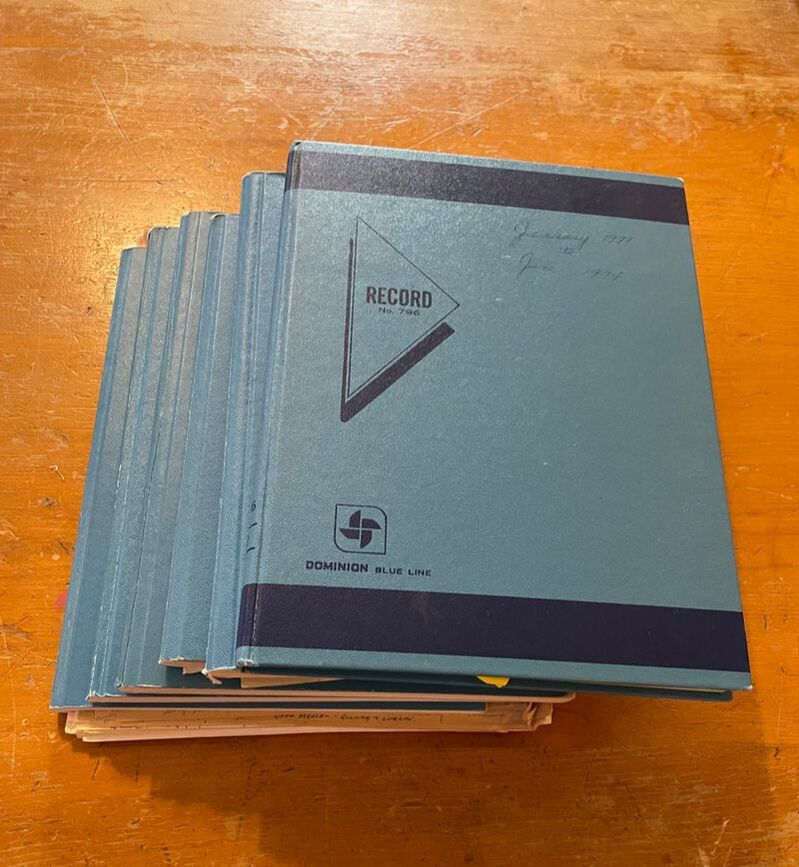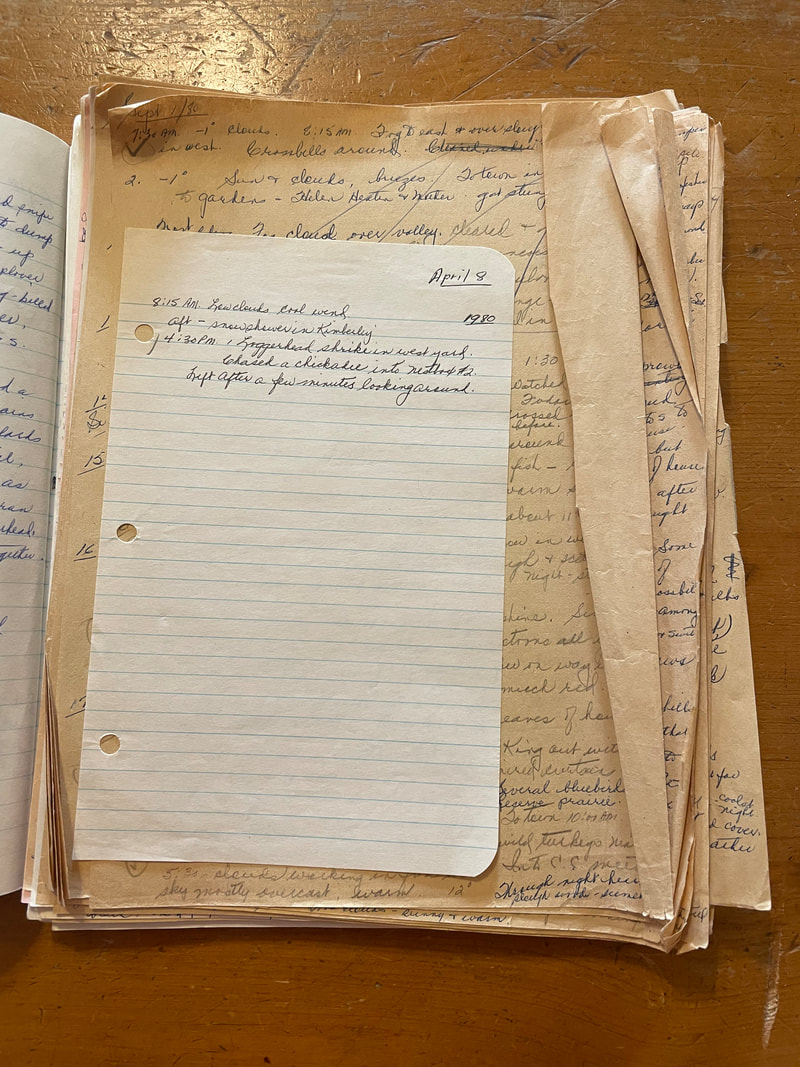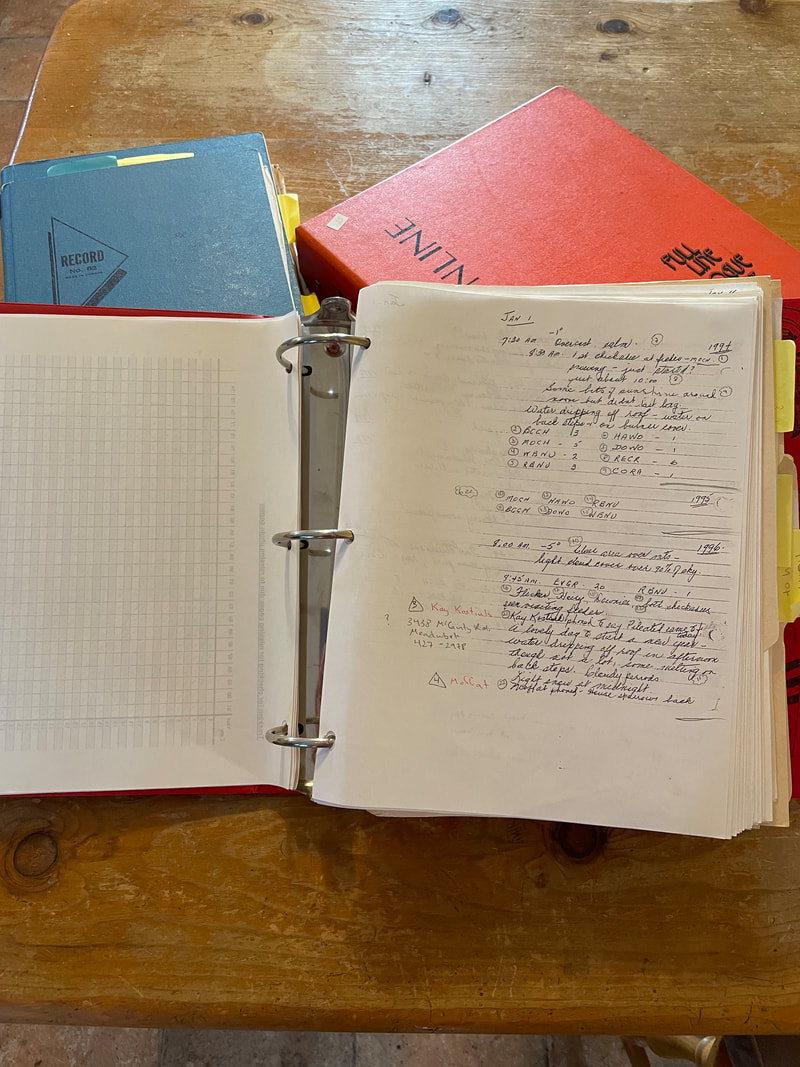Mrs. White recorded her bird sightings between April 1964 and December 2001. She wrote them down in 6 Blueline brand record books, which are in journal-style, and 5 black ringed binders, in list-style.
In December of 1974, Mildred and her husband, King, moved from a modest house on a small city lot in Kimberley to a newly built one on several acres south of Ta Ta Creek. The acreage was on the western edge of the vast grassy benchlands bordering the Kootenay River. They built a river-rock birdbath, standing over one meter tall. It attracted many birds, deer, coyote, and small mammals. They also put up several nest boxes and feeders for the birds and squirrels. A shelf-type feeder below the utility room window was easily accessed from indoors during the winter. In especially cold weather Mrs. White stocked it with her homemade shortbread, a special treat for the birds.
A variety of bird habitats were within walking and listening distance of their property. There was a creek with beaver ponds — Waite Creek, which flows into Bartholomew Lake, and Sun Marsh, named after Joe Sun, a resident of the acreage adjacent to the Whites'. The Suns operated a market garden with home delivery service of vegetables.
Mrs. White enjoyed traipsing around Wasa Sloughs. The lack of city services gave her an excuse to make the trip across the Kootenay River Valley to the refuse station south of the Sloughs. From there she would head for the Sloughs, taking a dirt track north through the pine forest to a clearing we now call "Mildred's Meadow". It was her tradition to check this field for the first of the spring buttercup blooms peeking up between the thick litter of pine needles. This signaled spring was in full flight, the ice would soon be off Wasa Sloughs, so it was time to start looking for the spring arrival of birds. Mr. White built a small boardwalk and viewing blind at the end of a spit on the east side of the Sloughs where they photographed waterfowl. It was still functional in 1979 and I used it several times myself when I first started birding; I didn't know the White's then but had heard about them, everybody had. They also had a portable blind they set up at Sun or Bartholomew Marshes.
She recorded sightings for Project Feederwatch, the Breeding Bird Survey, American Birds / Northwest Field Notes and the BC Sight Record and Nest Record Schemes, the latter two provided data for the four-volume work "The Birds of British Columbia", by R. W. Campbell and others. Other activities and projects she worked on were for the Rocky Mountain Naturalists, the Federation of BC Naturalists, and the Rocky Mountain Trench Natural Resources Society. She helped start two of the local Christmas Bird Counts.
Mildred was also a guest speaker at Wasa Lake Provincial Park, using her own and King's slides in her presentations. She wrote a nature column in the Kimberley Bulletin for many years. In 1996, she and other members of the Rocky Mountain Naturalists composed the "Rocky Mountain Naturalists Wildflower Checklist" commemorating the tenth anniversary of the RMN. And they also made a "Birding Tour" brochure.
In 2000, at the age of 84, she took a computer class at Kimberley Campus of the College of the Rockies to learn Microsoft Excel. Because of her experiences with other data banks, she was determined to get her data digitized and distributed. She would contribute records to many organizations and people but then would never hear of how the data were used or what help it had been. In some cases, reports and publications were unpublished and difficult to access. In other cases, the cost of obtaining published copies was prohibitive. If she'd been around when cell phones and the eBird app came out, I have no doubt she would have embraced them both whole-heartedly. Also, Mrs. White wanted to acknowledge the hundreds of fellow bird watchers who told her of the birds they'd seen, accompanied her on field trips, sharing their enjoyment of birds.
I continued with the project and five years later, in 2006, "published" a database containing data from her black ringed binder notebooks: almost 24,000 bird, animal, and plant sightings of Mrs. White's and over 200 other contributors over 27 plus years. The database was disseminated to anyone who requested a copy. The Species Inventory Project, Government of British Columbia uploaded the sightings to their online database, making it available to everyone. Dr. Mike Panian of the Species Inventory Project said the database was the “largest one-time contribution by a single person in the history of the provincial databank!”
Also in 2006, Dick Cannings, an ornithologist with Bird Studies Canada at the time, and current MP for South Okanagan—West Kootenay, uploaded approx. 17,500 of the bird sightings to eBird. eBird is an online database of bird sightings contributed by citizen scientist launched in 2002 and operated by Cornell University, New York. Mrs. White's sightings jump-started eBird in the region. Twenty years later, birders, researchers, and naturephiles find eBird almost indispensable for its data and an inspiring and invaluable resource for their birding activities.
Now, thanks in part to the pandemic which allowed me to focus my undivided attention on the onerous task of going through her narrative journals, I was able to glean another 6,900 or so bird sightings from her Blueline books. Between the interesting antics of chipmunks, what plants were in bloom, what subjects were deemed promising enough to use up costly photographic film and maybe good enough to pay for printing, where King went fishing and with whom, who dropped by for a visit - friends, family and fellow birders, and what birds and animals they reported, were records of her first time seeing many East Kootenay species.
eBird now houses over 24,000 of Mrs. White's bird sightings. Perusing the East Kootenay checklist on eBird, looking at the date of "first seen": Mrs. White recorded the first sightings of 160 species in the region (we have 348 species but only 306 are on eBird). This is eight times more than the contributor with the next "most firsts", Ian McTaggart-Cowan. Dr. McTaggart-Cowan visited the Newgate area in May of 1930 and recorded the first sightings of 20 of our species. Mrs. White's first "first" was two Killdeer flying down Mark Creek on 5 Apr 1964, and her last East Kootenay "first" was 19 Black-necked Stilt at Elizabeth Lake on 26 Apr 2001.
Her journals will be digitized and housed at the Royal British Columbia Museum for anyone to read. It has been over twenty years since Mrs. White's passing yet her 37 years-worth of fauna and flora sightings remain as an inspiration and a valuable source of information about nature in the East Kootenay.
The End





 RSS Feed
RSS Feed
